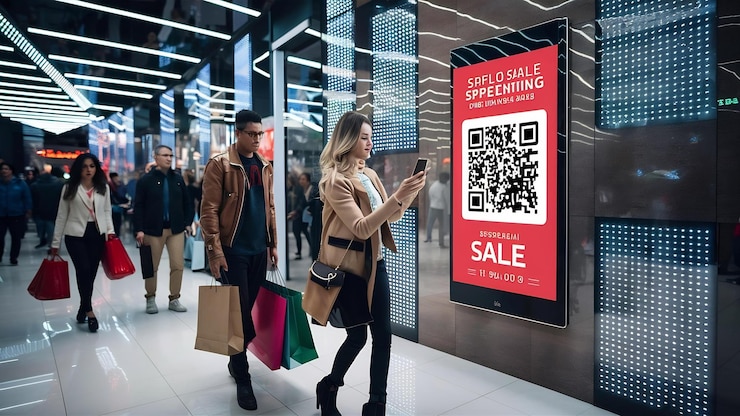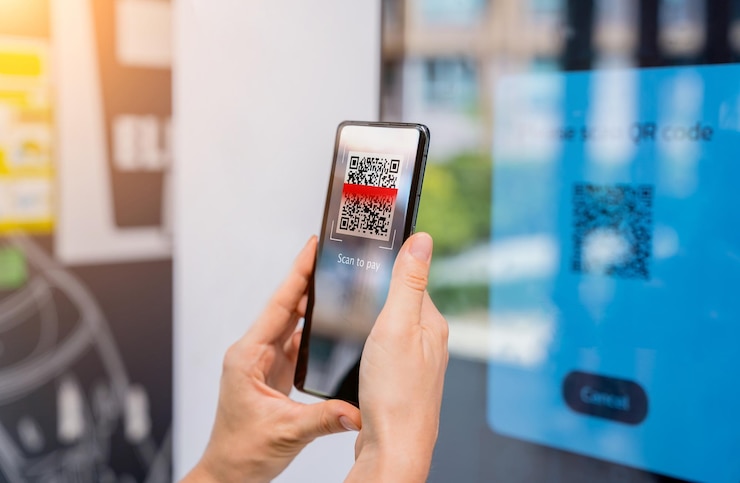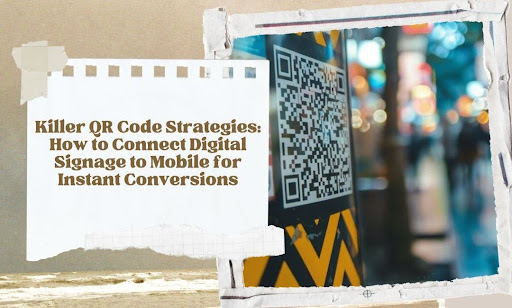QR codes aren’t dead. They were misused. Stuck in the corner of a screen. No call to action. No context. No reason to scan. But when they’re set up right—with the right placement, timing, and incentive—they move people fast. From glancing at a screen to scanning their phones. From static branding to mobile conversions.
Here’s the truth: Pairing digital signage with mobile isn’t futuristic—it’s overdue. And, QR codes are the missing link most businesses still treat as an afterthought.
This article isn’t about adding a QR code to your screen and hoping for the best. It’s about setting mobile conversions up on purpose—with strategies built to close the gap between your screens and your customers’ devices.
In this article, we’ll cover:
- How to connect digital signage to mobile for instant conversions
- The 5 best ways to use QR codes on digital signage
- How QR codes can increase engagement by 300% when used correctly
- Real-world examples of QR-driven digital signage campaigns that worked
If you’ve been underusing that square black-and-white box—or haven’t set one up yet—you’re exactly where you need to be. Let’s break this down and show you how to pull conversions in from your QR codes’ digital signage, one scan at a time.
Stop Wasting Screen Space — Pull People In with Their Phones
Most digital screens talk at people. The smart ones talk with them. Connecting your signage to mobile isn’t about throwing a QR code on the screen and walking away. It’s about creating a fast, frictionless handoff—from screen to smartphone—where the viewer takes action while they’re still paying attention.
That’s how you turn awareness into conversions. Fast.
Start with One Clear Offer
Before anything else, give them a reason to scan.
This isn’t the time to be vague or clever. You need to spell it out.
- “Scan to order ahead.”
- “Scan to win a free drink.”
- “Scan to see today’s limited deals.”
Make it irresistible. Make it obvious. And keep it short enough to read at a glance.
Match Timing to Attention Span
- What’s on screen when the QR code shows up matters more than most realize.
- Looping through content too fast? You lose them.
- Leaving a static code up the whole time? They tune it out.
What works better is to build the scan into the content flow. Frame it with motion. Trigger it after a hook. Let it appear with purpose, not as an afterthought.
Think Through the Funnel
The moment someone scans, they’re stepping into your funnel. So ask yourself: What happens next?
- Are they landing on a mobile-first experience?
- Is the offer instantly visible and tappable?
- Can they convert in under 10 seconds?
That’s the bar. If you’re linking out to a clunky page that doesn’t load, you’re throwing away conversions. This is where so many campaigns break down—they start strong, then fall flat on follow-through.
Design for the Distance
Most screens aren’t viewed from two feet away. That means your QR codes can’t be tiny.
Here’s a baseline:
- 20–25 inches minimum on large-format displays
- Clear contrast between code and background
- Enough breathing room around the code to avoid visual clutter
Add a Clear CTA and Visual Cue
Don’t assume people know what to do. Nudge them.
- “Point your camera here.”
- “Scan to grab it now.”
- “Use your phone to get this offer.”
Pair that message with an arrow or animation that pulls the eye in. Let the screen guide the action, not just sit there.
When you set the handoff up correctly—from signage to mobile—you don’t need to hope people engage. You set the action up and watch it get carried out.
Smart Ways/Strategies to Make QR Codes Work on Screens

QR codes don’t convert on their own. The way you set them up, time them, and frame them makes all the difference. Here are five ways to use them that actually push people to take action—without guessing or hoping for the best.
1. Push Instant Discounts or Promo Codes
QR codes can compress the conversion funnel, especially when tied to short-term offers. But for the scan-to-discount flow to actually drive action, you need three things working together:
- Content framing: The call to scan must be wrapped around a clear, high-contrast value proposition. Use bold text, time-sensitive visuals (e.g., countdown overlays), and animations that pull the eye in.
- Scan placement: The code should be on-screen long enough for the full scan-to-click process—typically 8–12 seconds, depending on foot traffic speed and viewing distance.
- Mobile-first redemption: Post-scan, the user should land on a lightweight page with a clear reward (e.g., “Your 20% Off Code: FAST20”), not a homepage or menu.
This is where mobile digital signage integration starts pulling its weight. A well-placed QR code connected to dynamic content scheduling systems can adapt in real time, giving you the flexibility to run personalized discount campaigns across locations without the guesswork.
Pro tip: Trigger these discount QR codes during low-traffic hours or product push campaigns to help move stale stock or improve digital signage engagement throughout the day.
2. Collect Contacts for Loyalty or SMS Marketing
QR codes are permission-based acquisition tools when used correctly—and far more effective than clipboard forms or kiosk terminals.
To make them work, follow this logic:
- Trigger a branded opt-in page: Don’t use a default form template. Branded opt-in pages with minimal fields (name, email, optional phone) increase completion rates by up to 40%.
- Pre-load with UTM or geotags: Append the scan URL with identifiers tied to store location, promotion ID, or display loop. This helps your CRM or email platform auto-sort new contacts based on behavior.
- Sync with your tech stack: Use QR tools that push contact info directly into platforms like Klaviyo, ActiveCampaign, or Attentive. That removes manual work and lets you automate follow-ups instantly.
Technical bonus: Use double opt-in with SMS consent fields. Not only is it required by TCPA compliance in the U.S., but it also protects your list from fake signups and helps you build a high-intent audience.
3. Trigger Product Demos or How-To Videos
When digital signage screens are used in physical retail, fitness, or medical settings, most buyers aren’t ready to commit yet—they need more context, proof, or education. QR-triggered videos offer an instant way to:
- Extend dwell time: Scanning a code to watch a 60–90 second product demo on mobile gives you a captive, self-guided viewer.
- Bridge the knowledge gap: Use QR codes to connect people to key proof points—like before-and-after case studies, interactive 3D renderings, or step-by-step install videos.
- Reduce pressure on in-store staff: Customers who understand the product better before reaching the register are more confident and less reliant on floor assistance.
Deployment tip: Use motion-triggered or contextual signage to show the code only when it makes sense—like when a person pauses in front of a product zone or during certain times of day when interest spikes.
4. Link Directly to Mobile Ordering
This one’s about speed, simplicity, and reducing operational friction. Instead of forcing customers through a kiosk or counter, use digital signage QR codes to:
- Route to your mobile ordering flow: This could be a native app or a mobile-optimized web app. Either way, the landing page should immediately show food categories, the most popular combos, or upsell items.
- Pre-load order context: Append variables to your QR link that tie it to a location, screen ID, or daypart campaign (e.g., ?store_id=57&campaign=lunchrush). This data lets your backend serve relevant offers automatically.
- Auto-apply discounts or rewards: Use mobile wallets or customer IDs to trigger stored points, “skip the line” benefits, or location-based perks.
Operational benefit: This setup reduces cashier dependency, shortens queue times, and increases average ticket size—especially during high-volume windows like lunch or early evening.
5. Send Traffic to Location-Based Landing Pages
Generic landing pages kill conversions. By tying QR scans to geo-specific endpoints, you create personal relevance, which directly impacts action rates. Here’s how to set that up:
- Build location-specific URLs: Either use a short-linking tool with dynamic redirect rules (e.g., URL shorteners with geolocation routing) or create separate campaign pages for each location.
- Pass variables in the QR URL: Attach identifiers like ?store=chicago-loop&screen=window-left. Your analytics platform can then track engagement per screen, per city, or even per department.
- Use screen-contextual CTAs: A display at the entry might say “Scan to check in” while a screen near the checkout could say “Scan to rate your visit.” Both flow into different segments but are tied to the same physical space.
Advanced move: Feed scan data back into your signage CMS. If certain locations show higher scan rates, increase the frequency or expand the on-screen CTA to drive even more traffic.
What Happens When You Set QR Codes Up the Right Way

It’s not the code. It’s how you set it up, frame it, and follow it through. QR codes, when built into the signage flow correctly, don’t just boost engagement—they multiply it. Not in theory. In actual campaigns. Let’s get into what drives that kind of lift.
300% More Engagement Is Possible—And Proven
A report analyzed over 2,000 QR-integrated signage campaigns and found that optimized QR code placements led to a 300% increase in interaction compared to static signage without QR triggers. That stat isn’t inflated by QR curiosity alone.
It’s the result of:
- Contextual placement (e.g., high-traffic product zones, checkout counters, and transit waiting areas)
- Value-forward messaging (discounts, how-to content, mobile perks)
- Clean, high-resolution codes that load fast and are large enough for passive scanners to catch
When the QR is part of the experience—not a bolt-on—you get more scans, more clicks, and more opt-ins.
Why the Uplift Happens
People expect screens to advertise. They don’t expect them to give them something back. That’s why QR engagement spikes when:
- The message is clear (“Scan for 15% Off—Today Only”)
- The code is framed with motion or contrast
- The mobile landing page is fast and action-ready (e.g., a discount auto-applied in a mobile cart)
That combination sets up a dopamine loop. Instant reward. No wait. No confusion. One quick scan, and they get what they came for—or better.
And Then It Keeps Going
Once someone interacts with your signage via QR, you gain a trackable entry point into their behavior:
- How many people scanned
- What time and day scans spike
- How many tapped through to complete the next step
Those metrics feed back into your campaign decisions, making your signage network smarter over time.
Insert case study opportunity here. This is a great spot to include a retail or QSR example showing scan rates increasing after optimizing placement, CTA language, or mobile load times. The big takeaway? You don’t need more screens—you need to pull more out of the ones you already have. QR codes, when used the right way, let you squeeze performance out of every pixel.
Global Brands Using QR Codes to Drive Real Results
Big brands aren’t guessing when it comes to mobile engagement—they’re engineering it. Some of the most effective examples come from companies that paired digital signage offers with QR codes on purpose, not as a gimmick. These strategies do more than engage customers—they’re structured to improve customer satisfaction, support larger marketing strategies, and direct customers to actions that move the needle.
Here are two real-world examples from brands you already know.
KFC Streamlined Ordering with Scan-to-Order Displays
KFC rolled out digital signage screens across select locations and paired them with QR codes for mobile ordering—especially in high-footfall, dine-in environments. Instead of waiting in line, customers could scan the code, access a mobile-optimized ordering page, and place their meal request without interacting with a cashier. The signage loop would prompt users with a rotating CTA: “Skip the line. Scan to order now.” This setup cut down queue times, boosted self-service orders, and reduced strain on staff during peak hours.
This approach didn’t just speed things up—it helped target audience segments that prefer self-service and tech-driven ordering experiences. It also aligned with broader marketing efforts aimed at simplifying in-store operations.
By placing the QR front and center—framed inside the menu loop and supported by animations—KFC made scanning feel natural, fast, and worthwhile.
IKEA Drove Deeper Engagement Through Product Information Scans
IKEA’s digital signage doesn’t just show products—it connects them directly to mobile via QR-enabled digital displays showroom.
Near key products or furniture zones, IKEA uses large-format screens with rotating visuals and QR codes tied to:
- Product specs and sizing guides
- Styling suggestions
- Real-time inventory updates
Shoppers could scan while browsing, get answers on their phones, and even save items for later pickup or delivery—all while remaining inside the store. This move bridged the gap between passive browsing and active decision-making, helping implementing digital signage in a way that enhanced customer engagement without disrupting flow. The result? Increased brand visibility and a smoother path from interest to action—without the need for a sales associate.
It’s smart digital advertising in its most useful form—where screens don’t interrupt the shopping experience but support it, one scan at a time.
Conclusion: Make QR Code Conversions Simple
QR codes aren’t the feature—they’re the trigger. When built into digital signage correctly, they don’t ask for attention—they pull it in. You’ve now seen how leading brands use them to cut friction, guide customers, and close the loop between what people see and what they do.
You’ve also seen how the right approach can turn any screen into a conversion point. No guesswork. No clunky setup. Just mobile-driven results that make sense for your business and are easy for your audience.
And if you’re looking for a system that’s already built to carry that strategy out—from screen setup to scan tracking to full mobile follow-through—that’s exactly where CrownTV fits in. With our secure dashboard, high-powered media player, and plug-and-play QR integrations, we don’t make you work harder—we make the system do the work for you.
Here’s a quick recap of what we covered:
- How to actually connect digital signage to mobile in a way that leads to conversions
- Five high-performing QR code strategies that pull people from screen to action
- The technical principles behind that 300% engagement lift when QR codes are used correctly
- Real-world examples from KFC and IKEA show how top brands get mobile buy-in through signage
You’ve got the blueprint. If you’re ready to set the system up without lifting a finger, CrownTV is built to make that switch seamless. Let’s bring the scan-to-convert experience to life—screen by screen.
What You’ll Get When You Set Mobile Conversions Up with CrownTV
Pairing QR codes with digital signage isn’t complicated—if the right system is backing you up. CrownTV brings together everything you need to roll out a mobile-first signage strategy that runs without hiccups and drives action on-screen and on mobile. Here’s what’s on the table when you work with us:
- End-to-end display support without the stress: From selecting the right indoor or outdoor screens to installing them in high-traffic zones—including retail stores looking to speed up in-aisle conversions—we handle the heavy lifting so you can focus on what the screen says—not how it gets there.
- A dashboard that lets you control the action: Manage campaigns, update content, and track QR scan behavior from one secure interface. No technical team is required.
- On-site installation in all 50 states: Our network of licensed pros handles everything—mounting, wiring, setup, and testing—so your signage is ready to convert from day one.
- Media players that keep content sharp and responsive: CrownTV’s compact but powerful media box keeps your loops smooth and your QR codes live—no freezes, delays, or sync issues.
- A decade of signage know-how: With more than 13 years in the digital signage space, we’ve seen what works, what breaks, and what pushes engagement up. You’ll benefit from all of it.
- Planning that ties content to conversion: Our team doesn’t just install screens—we help you plan the strategy. That means smarter placements, tighter QR funnels, and signage that’s designed to pull people into action.
- Custom app integrations that plug right into your stack: Need your QR codes to trigger CRM flows, connect with social media platforms, or launch a local offer? CrownTV’s app ecosystem supports hundreds of tools for that.
- Help when you need it—fast: Whether it’s a small issue or a complex rollout, our support team keeps you running. No hold music. No finger-pointing. Real answers, real quick.
With CrownTV, every screen becomes a mobile entry point. Every QR code becomes a chance to convert. And every part of the system works together to pull results in—not push them out.

